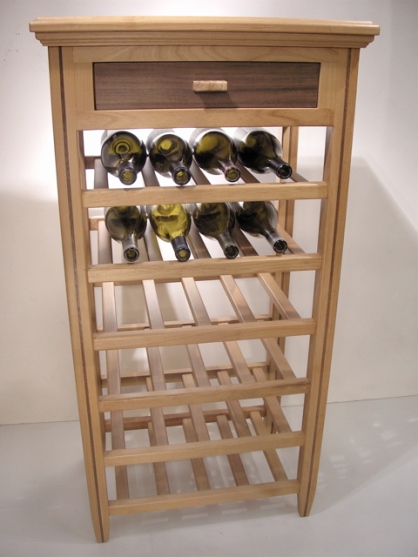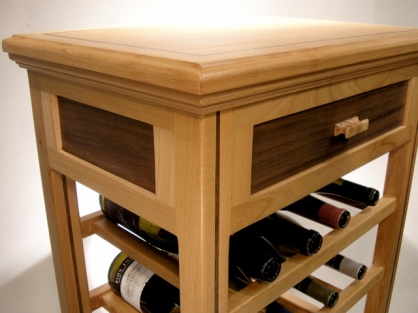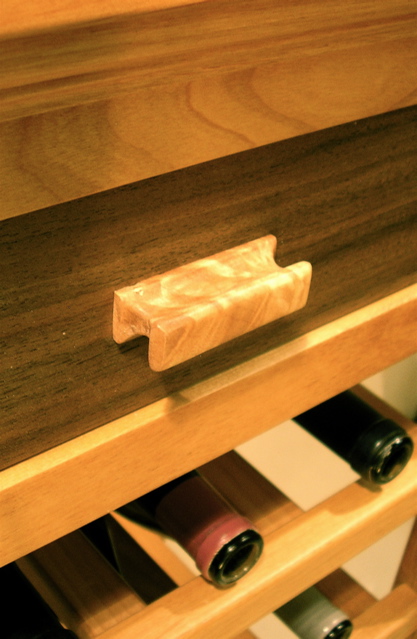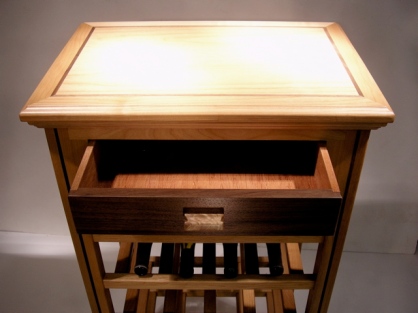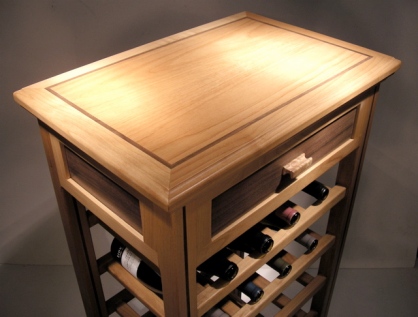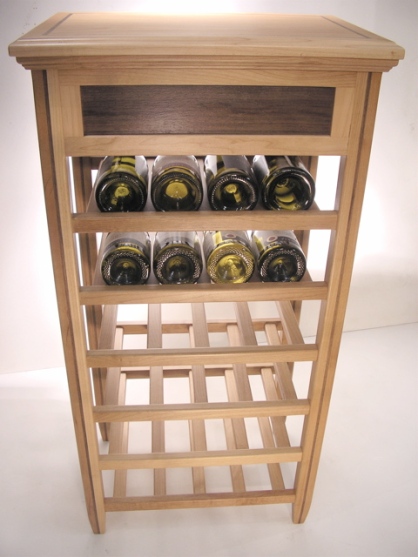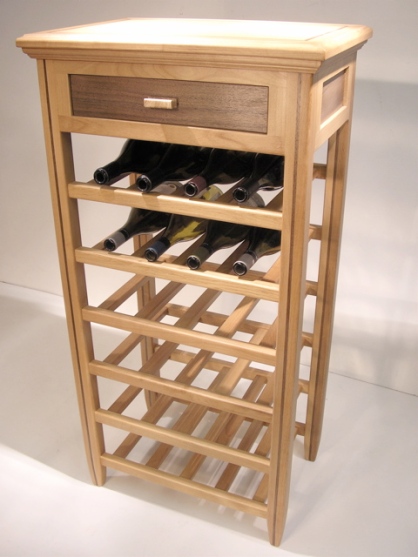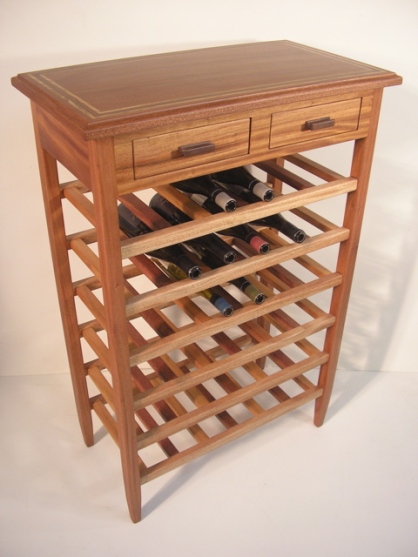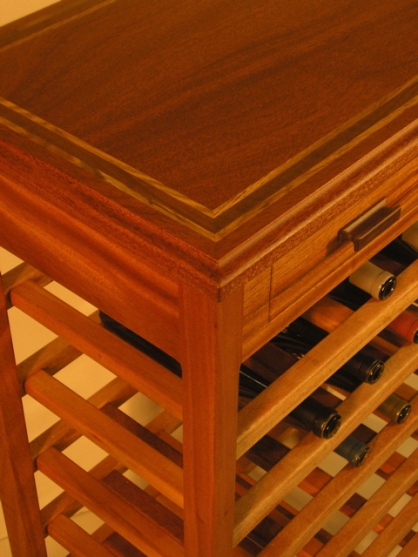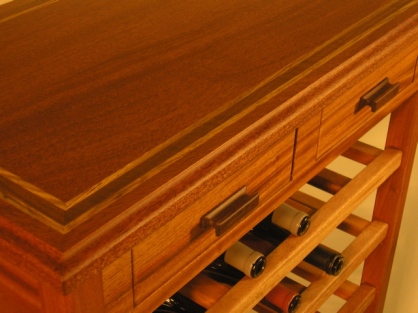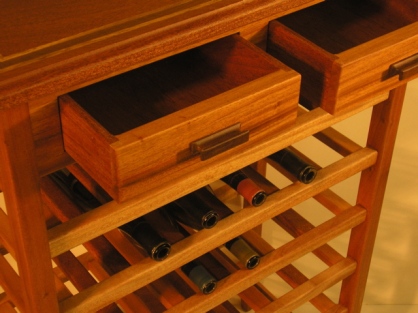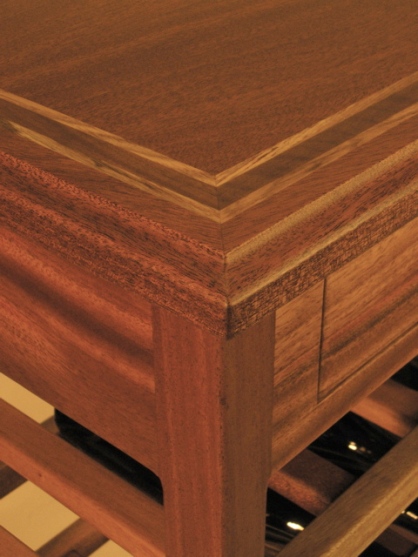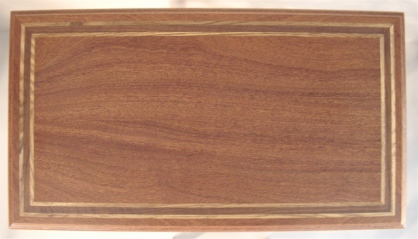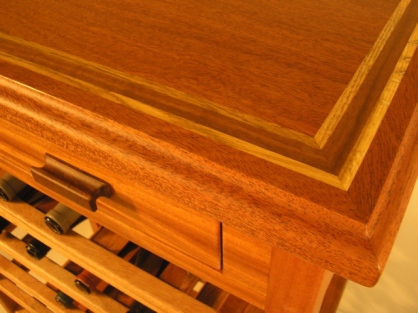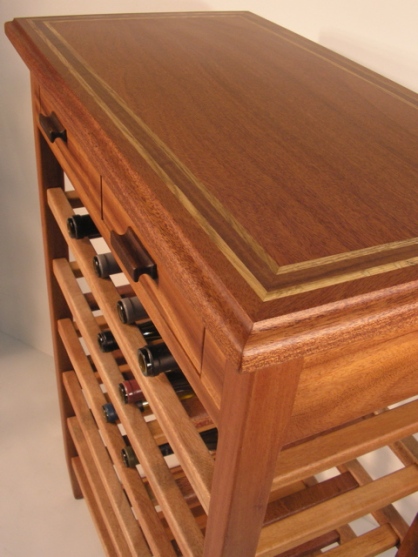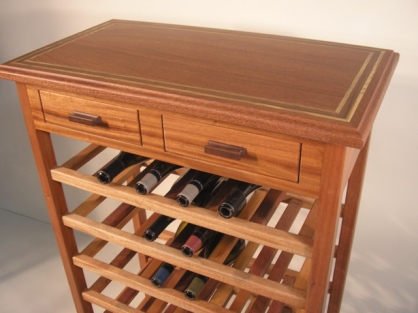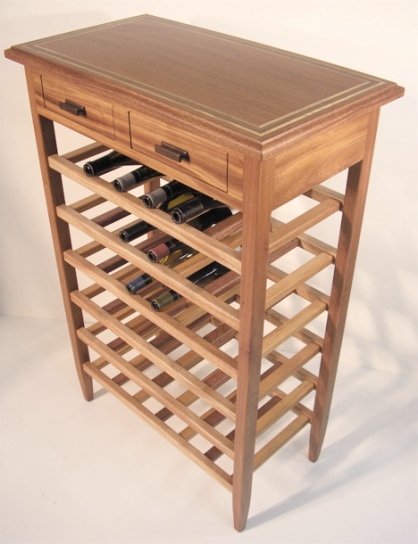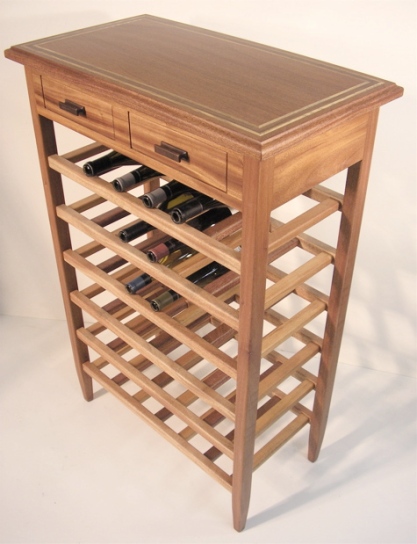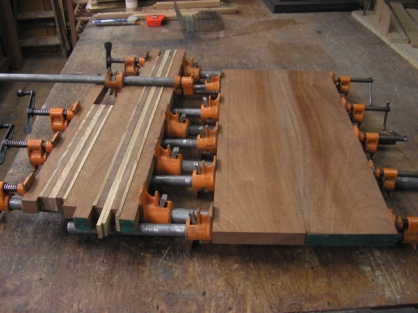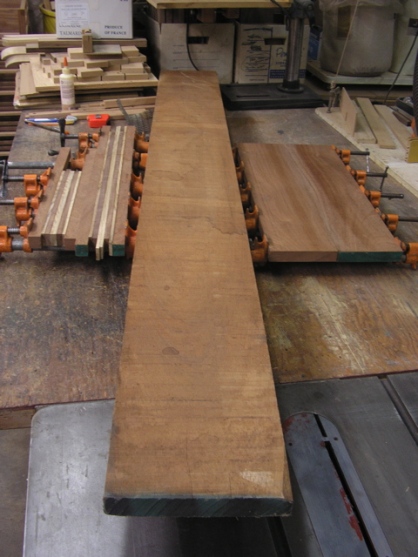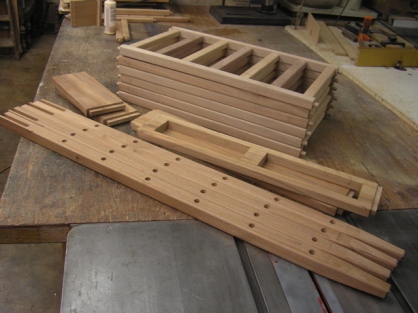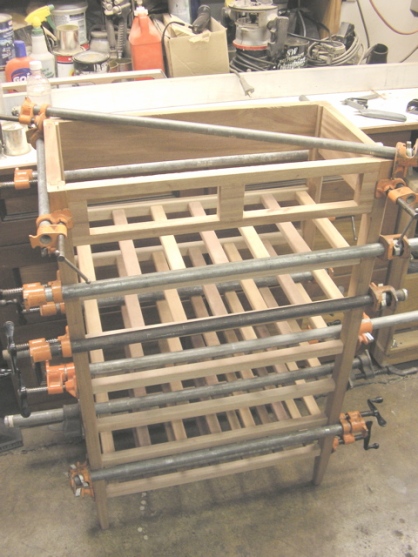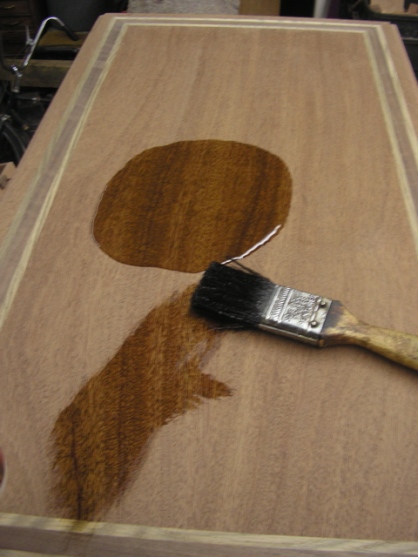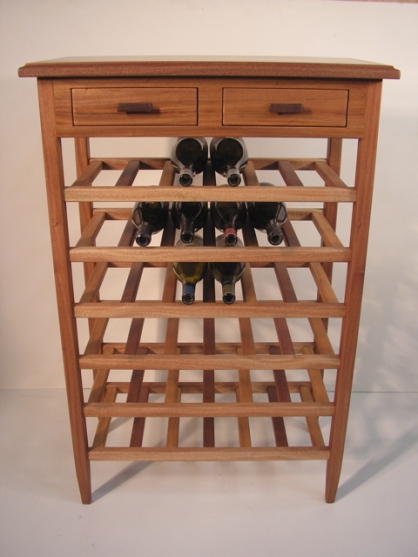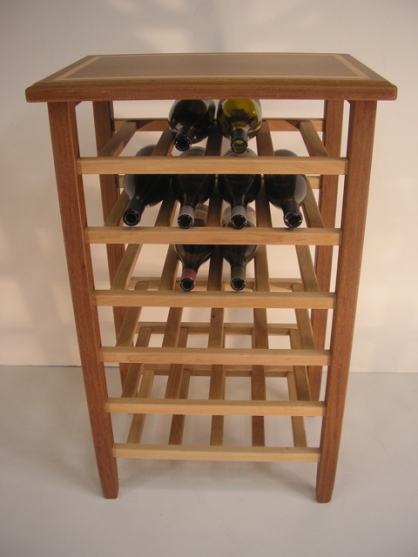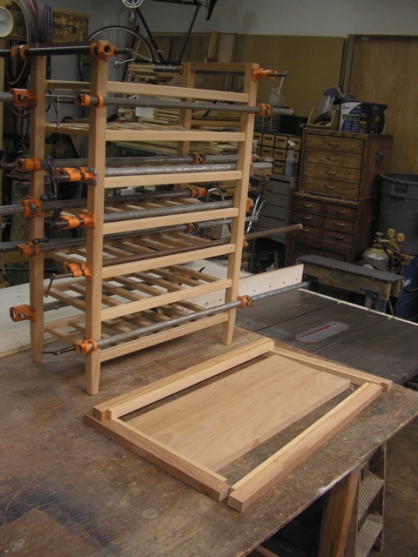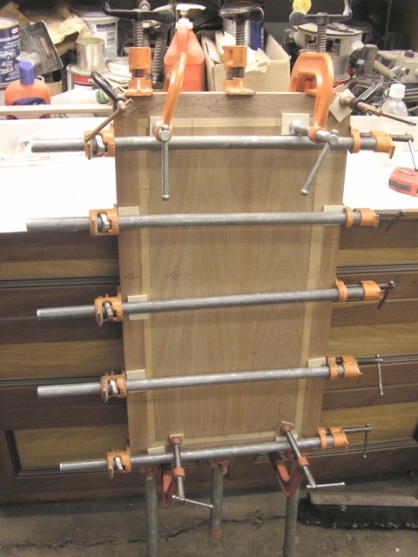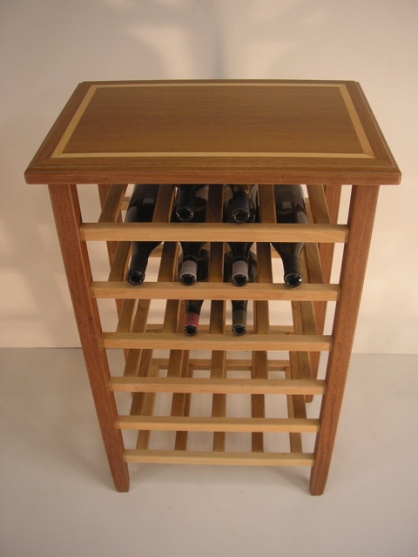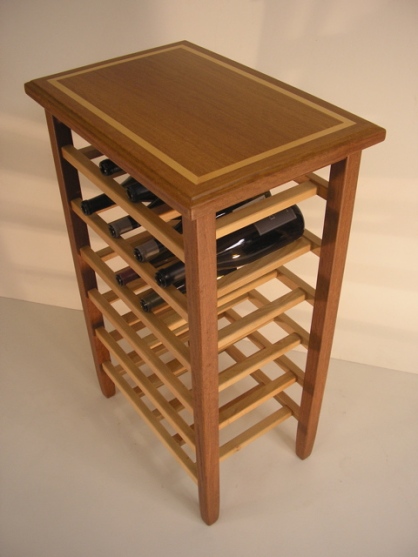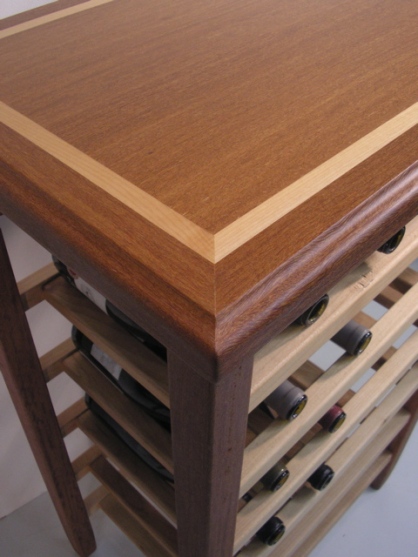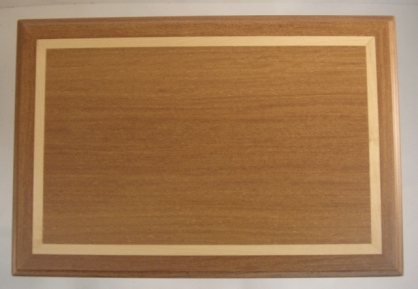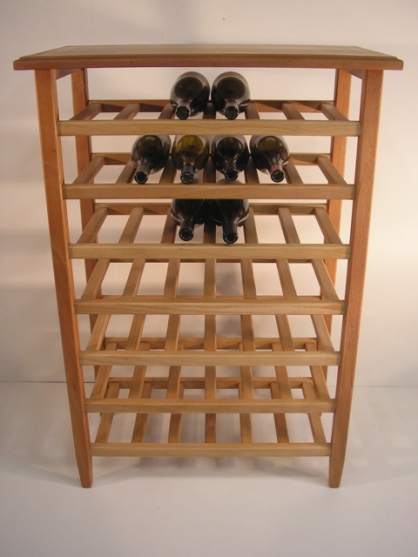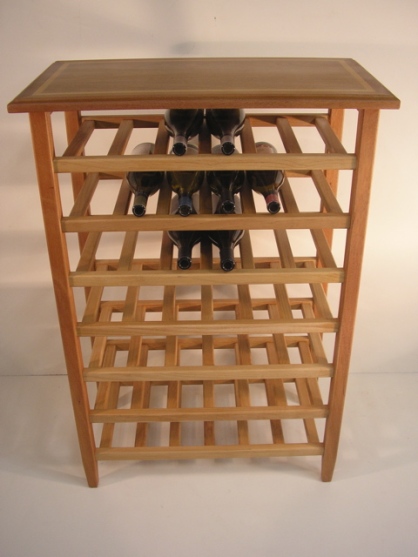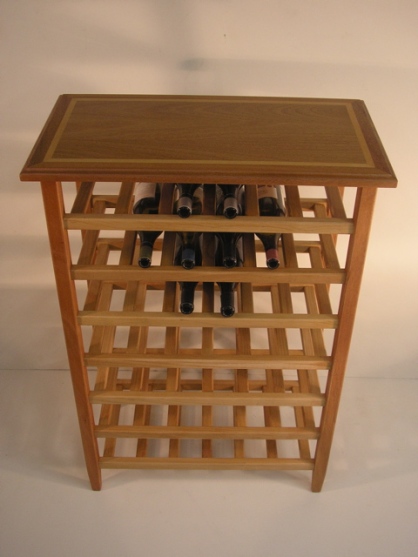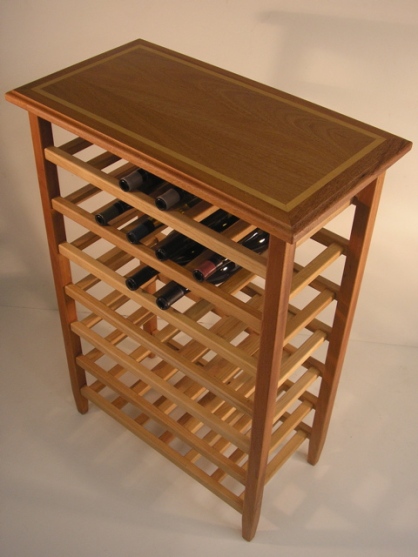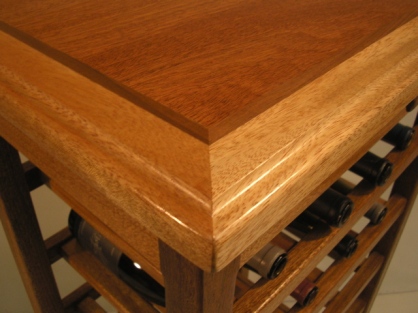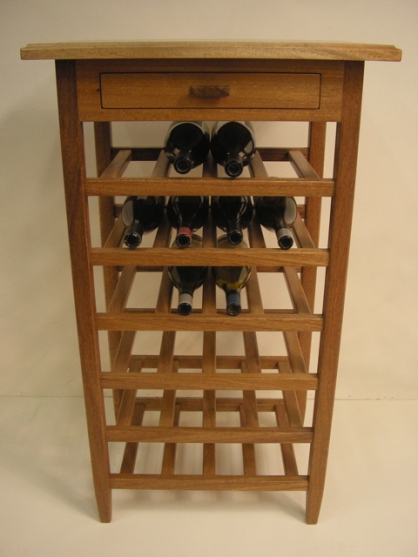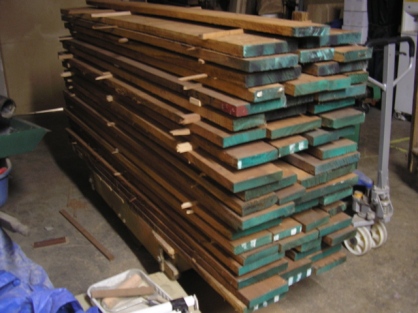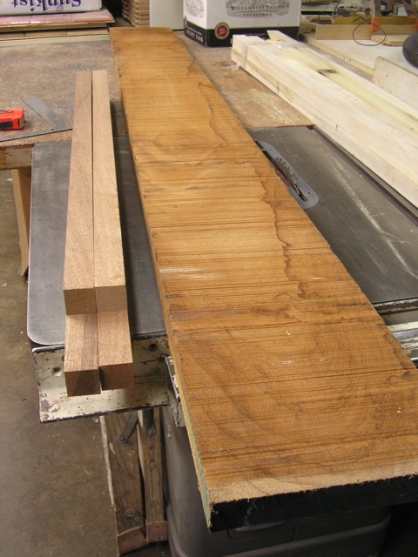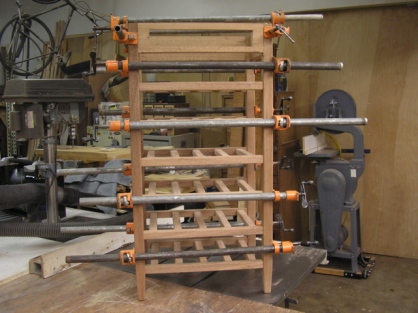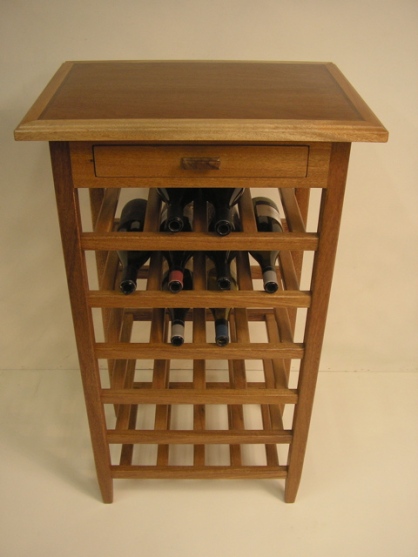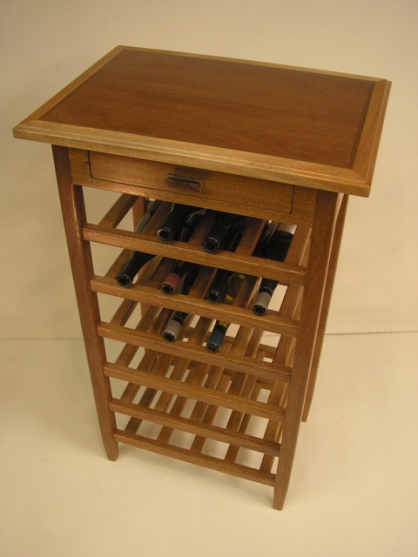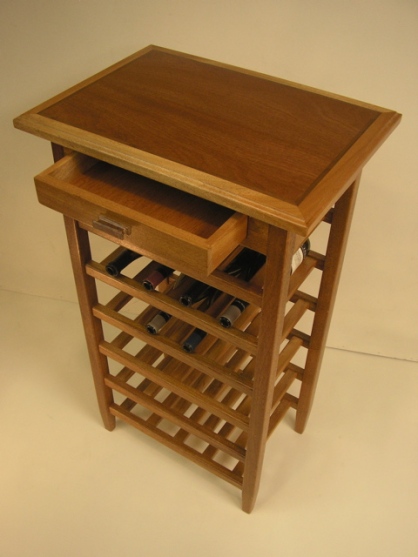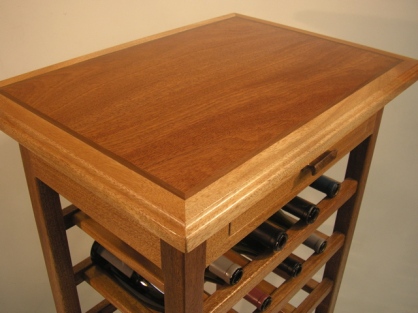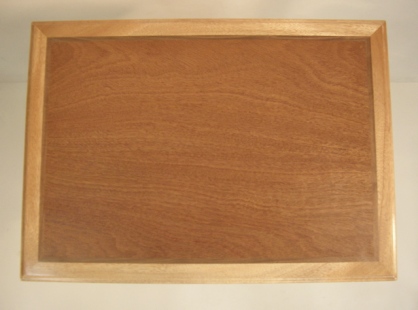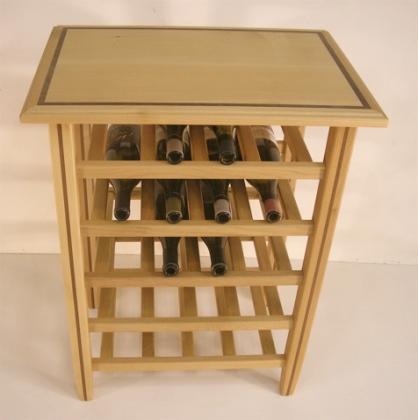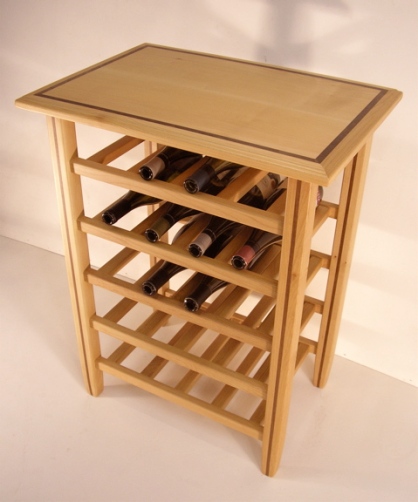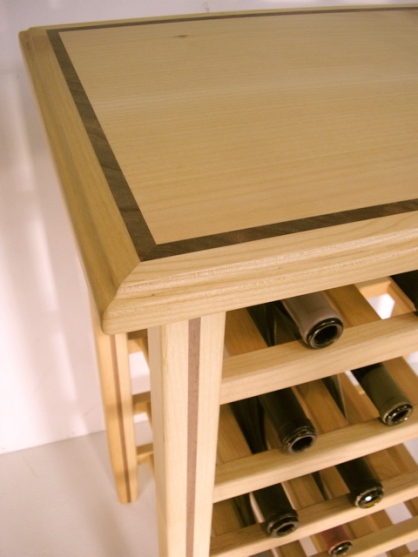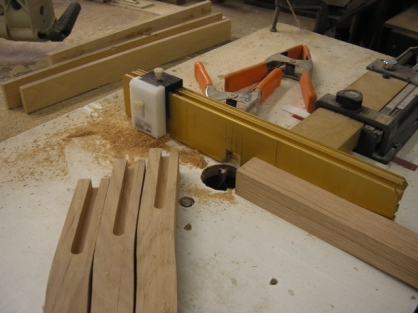Why Wood Wine Racks? Why Knot?
August 9, 2011
Yeah, why would I hand make wood wine racks? It’s not an easy answer… I don’t know… I don’t have a better idea?
I like to work and do stuff with my hands. Woodworking is a cool way to spend time. There are endless opportunities to learn about all kinds of things. A wise man told me that the thing that made it all tick was mystery.
I try to gather up piles of what is other wise wasted scrap material to make something. In this case, I had enough alder to make a taller piece, so I included a drawer and extra cornice molding. I have a few little design motifs that I use somehow on every piece I make. The moulding only works for me on taller pieces and I haven’t included it for a while. The mystery is, what works… what doesn’t? What could I make from this junk?
I do shop drawings and attach cut sheets so I can keep track of parts as I machine material for multiple pieces. Because of the modular nature of my basic design, I can and do change things as pieces get built. It starts with a little voice that asks what would happen if I…??
Some explanation why I make these things could be a kind of fascination with “stuff” and storing your “valuable stuff”. I saw comedian George Carlin way back in the ’60s and he did his famous routine about Stuff. I have always liked jewel boxes, display cases, cabinets that housed collections of stuff.
The real reason is that I read in the paper this week that the Oregon Wine Industry has grown from $500 million five years ago and now contributing $2.6 billion to the economy. The Mystery is how can I get noticed and find a slice of that?
The Ultimate Father’s Day Gift!
May 24, 2011
I have to post some more photographs of KTW#6011. Usually by the time I get a piece into the finishing process I’m already thinking about which one of the projects I have sketched and gathered material for to start next. For some reason this piece really makes me smile when I see it. With the stripes in the grain through the drawer carcase, it looks somehow alive.
I’m not so in love with it that I want it. First of all, I can’t afford to own my stuff. Second of all, I have a cool wine rack that I made from White Oak and Black Walnut a few years ago. It is much like this one with the two drawers, but a little smaller, holding 25 bottles. We have only had it full once. Mostly we only have a few bottles on hand, using the shelves to sort the newspaper and magazines. Then they are available to read when we eat, but can have a place to get that stuff off the table. We are Knot very hardcore drinkers.
I spent so much energy, literally blood, sweat and tears building it, that I can’t see getting enough money to part with it. This wine table on the other hand needs to go to a good home. Hopefully to live it’s life in a beautifully furnished kitchen, dining room or even a wine cellar.
My process is being refined with every piece I construct. I’m getting a lot faster and better all the time.
It still takes me an enormous amount of time to make these racks, and there is an element of risk in each step of the process. I just chopped up a table that has been sitting on a shelf for a few years gathering dust. I got 90% into it and made a mistake that I couldn’t recover from. Whoops.
The most difficult thing for me right now is finding nice material and enough material to make at least one individual piece. So far, so good. This Khaya wood looks so elegant. I have enough to make one more like this. I don’t know what I will do with it. I could save it and use it in contrast with other woods.
I think about design all the time. All kinds of design in all kinds of disciplines and media. Woodworking uses a similar kind vocabulary as playing improvised musics, say straight ahead Jazz or Be-Bop. There may be no lyrics, but still there is a kind of universal transference of feeling and emotion through melody, harmony and rhythm.
Working with hardwoods gives that same kind of opportunity for use as a kind of visual vocabulary. There is a kind of visceral transference of energy that happens too, because at one time these objects were alive and growing.
My hands have touched every single surface of this piece many, many times. In the end, I love being able to touch it and have it feel soft and smooth. I want the drawers to have just the right amount of slide and feel to them. I want to look forward to putting my fingers on the drawer pulls, because they feel right.
I could see this in a beach house or ski cabin, with some nice bottles of red parked there for those weekends that make the years memorable.
Your Wine Cellar Needs Another Wine Rack!
May 20, 2011
Here is another floor standing wine rack made from the Khaya (known also as African Mahogany). It’s a 6 X 6, six bottles wide and six racks tall, for three cases worth. The dimensions are 28″ x 15 1/2″ x 42″ tall.
Below: I have glued up contrasting edge band material and crosscut a board, then folded the board back on itself at the cut and glued it up for the field of the top.
There is a woodworking blog that I follow…
http://larrysworkshop.wordpress.com/
Lazy Larry has some very cool ideas about laminating different woods and creating interesting 3D patterns. I decided to start simply and use some of his basic ideas to create my table tops. Above: you see I have ripped some thin strips of White Oak from my dwindling stash that was dried from a fallen tree over on SW Crestwood Lane. I sandwiched a wider strip of Black Walnut, then glued them up with a wide strip of Khaya to form the edge band.
I’m not a very good photographer. I’m of the… take tons of pics… and hope some turn out OK, school of photography. Most of the time. I’m paying attention to what I’m trying to do in the shop, and forget to take shots as I go along in the process of building. Too many times I have stopped to take a photo, been side tracked, only to make mistakes because I forget what I’m doing. I hate that.
Next I milled up the board in the middle here for the legs, rack parts, carcase and drawers…
If I actually took photos of all the individual steps I go through, there would be hundreds of pictures. Unless you are into woodworking, it would be overkill, but I’m just trying to illustrate how many steps there are to making these things… how many steps there are for potential mistakes!
With every new project, I try to refine my ideas and processes, to be faster and still have a shot at quality.
Many woodworkers hate the finishing process. Some do great joinery only to apply bad finishes. I actually like applying finishes and with each piece, I add to my knowledge and experience. Still, it’s like shooting dice and no matter how hard you try there are potential problems. The experts know how to avoid problems and how to fix mistakes and any pitfalls that might occur. Most finishing materials are perishable products and you get one shot at it. Quality finishes are like shooting at a moving target… it’s difficult but not impossible.
Applying a finish is the payoff for me. After I have milled all the parts cleanly and glued everything up square and true, then sanded like crazy… seeing the grain pop out is like opening a present.
Lazy Larry’s lamination idea turned out really cool. I like it. I love the little ripples or “quilting” in the Black Walnut feature strip. There could be so many variations on this concept, I can hardly wait to try some more complex ideas.
More to follow…
Wine Tables, Wine Racks, Made In Oregon!
May 2, 2011
This rack was made from Machiche a very dense, hard, tropical lumber from Central America (sometime called Black cabbage-bark). The racks and feature strips in the mitered edge band on the tops is Alder from Oregon.
The dimensions are 23 1/2″ wide, 15 1/2″ deep and 37″ tall. The field here for the top was assembled from a piece of lumber that was cross-cut in two and folded back on itself. The edge band was cut from the same board so the color would remain consistent.
This Machiche is very hard and seems kind of brittle too, but it also seems dimensionally stable, resistant to expansion and contraction due to changing moisture in the air.
The grain is very beautiful. It’s subtle because at a distance it just seems to have a rich dark color, but up close the grain has a wonderful curly pattern.
The top turned out great. The glue joint is virtually invisible. It’s so cool when things turn out better or different from the way I envisioned them. I think the contrast with the light Alder wood turned out great. I love it when wood seems to have a golden glow to it.
I try as hard as I can to make each piece as well as I can. But still I make small mistakes and I’m working wood with it’s own challenges. No matter how much time or effort I put forth, things are never perfect, so I just do my best, work as quickly as I can, and try to get my kicks making different stuff from what ever material comes my way.
I always expect things to go wrong, because they already have so many times throughout each step of the process. Sometimes, I walk into the shop the morning after applying the final coat of clear finish the night before, and look at my pieces with kind of a detached amazement. Then it all comes back to me… oh yeah that was some idea I had way last month. I looked at some boards and thought I should see what would happen if I did this or that.
It’s great when I can think to myself… that turned out pretty good. So now, #0511 needs a good home and worthy bottles of wine to proudly display!
Wine Racks-Custom Designs-Made In USA
April 29, 2011
Six bottles wide by seven racks high, gives you a 42 bottle capacity. Notice how even the fat Champagne style bottles that many wineries are using for their Pinots fit without touching.
This legs and top of this rack was constructed out of Khaya also known as African Mahogany. The racks and contrasting feature strip laminated into the top are Oregon Alder hardwood.
It is 40″ tall, 28 1/2″ wide and 15 1/2″ deep.
I apply three coats of poly-urethane that is virtually water proof and very stain resistant. I use a satin sheen that brings out the natural color and grain of the lumber, imparts a velvety smooth feel, and gives that hand-rubbed antique effect.
I’m surprised that through the whole stack of boards my neighbor Lavrens passed on to me, each piece has very different shades in the color, but yet has the same grain characteristics.
If you are a serious wine enthusiasts, you probably buy bottles a little too expensive or too many bottles that were a deal that couldn’t be passed up. You could treat yourself to a nice hand made rack like this to stash your treasures!
Free and Knot Free Wine Racks…
March 26, 2011
Lavrens, my neighbor at the shop, came through for me again. He has a buddy who works or worked for a Canadian lumber wholesaler. A few years ago when the economy was still functioning, they bought units of exotic lumber to sell to high-end users. As the economy was destroyed, they went back to selling construction grade lumber and plywood. That didn’t work either so they closed the warehouse.
When they cleaned out the building, this unit of lumber was not in the inventory, so Lavren’s friend gave it to him, and he gave some to me. It is an African Mahogany called Khaya Ivorensis or commonly Khaya.
I cut one of the pallet skids in quarters for some legs. I was impressed by beauty of the grain and the color. It is fairly hard and dense. I don’t like the way the sawdust smells. It is a little acrid, but not horrible like Ipe, and certainly not as nice as real Honduras Mahogany.
These must have been some big trees because it appears like all heart wood. It mills up straight and true with no warping or cupping. Nice to work with and easy to machine.
Since I had quite a lot of material to choose from, I decided to make a piece that is narrow and a little taller. It holds 24 bottles and has a drawer for cork screws, stoppers and wine glass charms. 23 1/2″ wide x 16 3/4″ deep X 40″ tall.
The top turned out great. I planed a piece, crosscut it, then joined it back on itself for the field. You can barely see the joint.
I used Oregon Black Walnut for the feature strip and drawer pull.
The edge band was from a different piece of lumber. It’s pretty amazing how different the colors turned out from piece to piece. After I sanded everything off, the colors seem rather uniform. The urethane I use made the grain and true colors pop out.
While the grain and figure from piece to piece is very uniform, look how different the legs are compared to the carcase, and the edge band against the field on the top.
Like I said, free from any knots… and my favorite type of wood too… free. Thanks Lavrens!
Knot another wine rack!
February 16, 2011
Yeah, another one. My neighbors who make custom upholstered furniture gave me a bunch of Alder scraps a few months ago. Every month or so, they get a unit of FSC Alder lumber and proceed to make piles of narrow rips and other scraps, perfect for me to mill into rack parts.
I generally try to make parts production style so I can efficiently produce two to four or five racks at a time. This one was cut out along with the rack on my last posting. My deal is to try making all my stuff out of solid wood and not glued up… if I can. It irritates me to look at production furniture and cabinets that boast solid wood, only to see glue joints everywhere.
As I have said before, it would be easy to draw ideas up, go to the lumber yard, buy a bunch of nice material and make cool stuff. The problem is that it costs money. If I could find ways to sell these things and recover that cost, I would be cranking out wild stuff from the many pages I’ve sketched in my design note books.
Sometimes I can find big enough pieces to make solid legs, but in this case, the scraps were wide and long enough, but not thick enough. To solve that, I laminate a different kind of wood so it becomes a part of the design, not just a way to use thinner (cheaper) material, like the typical manufacturing process. In the end, it’s no doubt cheaper, easier, to buy thicker 8/4 material for the legs, but like I said, it cost money. I have way more time than money. I began laminating parts so that they becomes part of the design and look on purpose. In this case, Oregon Black Walnut milled from some logs I dried.
The field for the tops are usually two pieces glued up, either book matched or a single board folded back on itself at the cut, so that the grain matches and many times make the joint invisible. I started using a contrasting feature strip when I laminate the tops for the same reason… make big parts out of small pieces and have the laminations be part of the design.
Knot normally the way I do it…
February 10, 2011
A lady saw photos of a wine rack I posted for sale on craigslist and contacted me. I invited her to the shop to see what different pieces I have in my inventory. She had a corner in her dining room where she wanted to place it and we discussed dimensions.
She looked at completed racks and I explained how the modular nature effected the over all dimensions. She gravitated to a piece that was constructed from Black Walnut and Sapele, and said she really liked the redish color of the Sapele… also know as African Mahogany. She ask what color of stain I used.
I had to laugh and said that there was no stain, I use different hardwoods to show off their natural color. There is no reason to use a stain. I do however use stains on the pieces I make out of soft wood like Pine, Fir or Cedar. I showed her a couple of those different pieces and some raw wood to illustrate how washed out the natural wood looks generally. She wanted, if not to match, at least compliment her dining room table.
She ask how much the Walnut/Sapele piece was and I said it was three times as expensive as the Fir/Pine ones. It was too small for her but she really liked it. I had to laugh again. I said, you have good taste, your like my wife. She sees a red car and says, wow that is a beautiful car, I want one of those. I say, baby you have good taste… that is a Ferarri. How about that red car over there? No, I don’t like that so much. Well Babe, that’s a Toyota.
I had three racks made from Alder that were recently glued up but I had not made tops for yet. They were the right dimension and bottle capacity for her. I showed her the two most common tops I make… Mitered edge band, with or without a contrasting feature strip, and the Breadboard style with through tenon joint.
She liked the Breadboard style, saying that the way I leave the tenon protruding matched her table’s styling. I told her that I never stain hardwoods, but that furniture manufacturers routinely apply stains to Alder. I pulled out my drawer full of sample stain cans and proceeded to wipe stain on some Alder scraps. The first one or two colors were spot on for her. So I made a Breadboard top, stained the piece and applied three coats of polyurethane.
She picked it up yesterday and said it looked great. As much as I would love to be purist, use highly figured exotic woods and tradition oil and wax finishes… I’m not a snob. In the real world, it’s only other woodworkers that really know the difference between a Ferrari and a Toyota… or care. While it’s Knot normally how I do things, it pays the bills. I did like the way it turned out and more importantly so did she. Thanks for the support… another one goes to a good home.
Knot a Wine Rack…
January 16, 2011
It has been about a year since I started this blog. 2010 was one of the worst years I have lived through. Almost nothing went right, I never caught a break and almost every single thing I tried to do, blew up in my face. I feel like a complete failure.
Having said that, I’m not alone. It was hard for almost everybody I talk with. I got a message from WordPress telling me enough people viewed my blog to fill two 747 air planes. Lot of good it did. I got very few comments and even less interest in my wine racks. It’s very disapointing and some what frustrating.
I’m going to try an keep the shop going, but I don’t see how. I don’t have any emotional attachment to it really. Carpentry and wood working is what I have been doing for a living for a long time and I don’t really know what else to do. I going to try and keep going until I can’t anymore. I enjoy the work but it’s not who I am or what I’m about as a person, just a way to try and make money.
This is a piece I built last month for a lady. It is to be used as a night stand. The shelves are for shoes and slippers. She gave me some rough idea of dimensions that would fit in the room and how high it should be for a reading lamp.
I looked through my piles of hardwood lumber and dried logs, but there wasn’t enough to make all the parts I needed in the sizes I wanted. Here is a shot of some Clear Verticle Grain Fir that I re sawed. It came out of a nasty looking old 6 x 12 beam, salvaged from a construction site. While it had some defects and a big knot, it is beautiful material.
It must have been a giant old growth tree by the close growth rings and how many there are. I’m always in awe when I think that every grain was a year… we must be looking at decades… generations to grow this tree.
Here is what’s left of a 2 x 12 somebody gave me fifteen years ago. It has some curly grain to it that is very delicate and most gorgeous. I used it for the legs and the laminated edge-band on the top.
I love the look and color of fir. It is very difficult to work with because it can be splintery and it’s not hard enough to resist dings and dents in furniture. I went with it anyway because it was free. Here are a bunch of parts and you can see that I cut the drawer fronts out of the face frame and glued it back together so that the grain would run through.
Here I am with the tenon cutting machine I built, making round tenons to join the legs with the shelves. I call it the pencil sharpener, because it’s like sharpening big pencils.
When working with fir, you need to have very sharp blades, bits and planer knives or else you get heart breaking tear out or splinters. Sometimes you may run a bunch of pieces through the router table very carefully and think you have it licked… then WHAM, a blow out that rips the piece apart so that the material is wasted.
There are tricks to dealing with this like “Climb Cutting” where you run the work backwards agains the bit so it doesn’t grab the splintery grain…. or making multiple passes, taking a small amount at a time… or both. But, still you never know when the fir will bite you.
I was lucky this time, because I used every trick I know to machine all these parts right the first time. I barely had enough material to design this piece and no spare boards for mistakes and mishaps. In the end, there was barely enough scrap to kindle a fire!
I didn’t make the same mistake that I did on the last piece I built where I flipped the face frame in my haste to glue up the carcase. It’s subtle, but for those who know to look, they are rewarded with the grain running through the frame and drawer fronts.
I mortised my signature drawer pulls that matched the grain too. The last two from a batch of pulls I ran years ago. It takes six router set-ups to make them, so I do it in big batches of all kinds of woods so i don’t have to stop in the middle of a piece and make some.
The thing that took me the longest and was the most difficult, was to design the shelves. The boards I had were just too narrow to use. So I had to come up with a way to make them wider. I drew a dozen solutions but the one I liked the most couldn’t be built. I mean I could draw it, but there was no way to glue and assemble it… looked nice though.
The feature strip in the top is from my dwindling stash of old growth California Redwood. You can’t see in the photos, but there are small “Bird’s Eyes” in the Redwood.
There were two defects in the board I used for the field in the top. I could cut one out, but not both. So, the squiggle you see is a huge splintery check that ran through the whole beam. I glued it and clamped it. When it was planed off it came out smooth. Hey, it was made by hand! This ain’t IKEA.
I sprayed three coats of poly-urethane varnish on it, sanding between the first split-coat and second full wet coat. Then I rubbed out the top coat with double ought steel wool. It gets rid of any sheen and makes it velvety smooth to the touch. It’s virtually water and alcohol proof and pretty stain resistant too. Sometimes candle wax will stain it, but it is the toughest finish I know how to apply.
Over time, it will get used, dented, scratched and dinged. Like I’ve said before, some day after I’m long gone, somebody will pick this piece up, see my signature on the bottom and know that it took took time out of my life to make.
What Next?
Knot How It’s Supposed To Work…
November 22, 2010
It can start with a need. In this case, a friend has been remodeling his house and needed to put a key in a door at the end of a hall. All he told me was that he wanted a table to put a lamp on, so he could see the door knob, and that the space in the corner of the hall was 10″ by not more than 18″.
I like to have some kind of symmetry in my designs and the one dimension that seemed fixed was the 10″. Quickly I thought, how about 10″ deep by 15″ wide and 30″ tall… multiples of five.
I looked through my piles of wood and lumber for some walnut but didn’t really find anything that jumped out at me. I uncovered some gnarly pieces of Red Oak that my friend had given me last year and I’d completely forgotten about. I planed off the sides to see some nicely figured pieces.
They were just 29″ long, perfect legs for a 30″ table height. I squared them up on the jointer and thickness planed them. There were a few defects, checks, splits and splintery grain. I also thought because the piece was pretty small, I needed to cut them down so they would make sense within the scale of the piece. Hopefully I could cut out the defects too.
I fooled around with a bent piece of quarter round moulding that I use with a string to adjust the bow for marking curves. My idea was to make curved legs and cut out the defects. I cut a piece of plywood the size of the leg blanks for a template.
The hardest thing to do was figure out the sequence of cuts so I’d have a flat surface to run the against the fence and get a square part with which to join the carcase. Here is the first cut…
…then flip it 90 degrees for the second cut, and still have a flat surface to run against the table.
Legs.
That was the end of the day. I had a few random pieces of Red Oak in my stash but not enough to do much. I left the shop that night about eleven thirty in a driving rain. I got to the end of block where there is a new and used resteraunt supply business. They always have stacks of pallets and cardboard set out for the recyclers. There was an Oak counter with white melamine top and shelves sitting in the rain. I got out, kicked the particle board sides and top off it, and stuck these nice raised panels in the truck,
Nice stash of free material, except that when I cut them apart, the panels had been run through a sander or planer and were only 9/16″ thick. Couldn’t use them for a top like I hoped. Oh well, the styles and rails were still 13/16″, so I cut them up. I couldn’t use the panels, so I rummaged around and came up with this…
 … a piece of Goncalo Alves that one of my shop neighbors gave me. It was an
… a piece of Goncalo Alves that one of my shop neighbors gave me. It was an
off cut from a big board he used to make cabinet doors.Next I laminated pieces of
the Red Oak from the styles and rails on the salvaged counter and laminated
Black Walnut for the feature strips in my new top.
Next, I miter the edge band and…
… and glue the top together. Next I made the carcase sides, cut out the drawer front.
I make the pieces a little wider than I want, so I can rip the drawer front out and glue the frame back together. The you see the grain pattern run through the piece. At least that’s the idea. Next I machine the tenons for joining to the legs.
Next I machine the mortices in the legs on my router table equipped with an IPM fence. Same deal, it was harder to figure out the sequence of cuts, so I had a flat surface to run against the table and fence, than it was to machine the parts.
The IPM machine allows me to make extremely tight fitting joints. I have to make them at least sloppy enough, so that when they get wet with glue, they slide together and won’t wipe the glue off the joint or have to force it together. Every click of the detent wheel moves the fence a thousandth of an inch.
I sand all my parts then glue up. Unfortunately, in my haste to get everything square and true, I flipped the front backwards and by the time I realized it, I couldn’t pull it apart again, the glue dries that fast.
I know and you know, but nobody else will every know. I make runners that fully house the drawer, so I can have tight fitting drawers that slide smoothly and positively. I should have dovetailed the drawer sides, but once I have made a mistake that I can’t or don’t want to spend the time recovering from, I just want to finish and see if the overall design works for me. Still, I make traditional box joints to hide the dado for the drawer bottom.
The drawer bottom was a scrap of Jatoba. I looked through a big box of my signature drawer pulls. It took me years to come up with pulls that felt good in your fingers when you open the drawers. I make them by the dozens because it takes six router setups to create them. I don’t want to stop and make one in the
middle of a piece.
Unfortunately, I used all The Red Oak pulls on a previous table,
but at the bottom of the box was one I made from Spalted Apple. Here I route a
mortice in the drawer front to accept a tenon on the back of the pull. A perfect
color match!
Finally I put it all together, did some finish sanding and applied three coats of a
water based lacquer.
When I showed it to my friend, he told me his father had worked at a millwork company in Tigard, Oregon for thirty years and that the pieces he had given me, were rejected turning blanks he brought home to burn forty years ago. My only cash outlay was for the Lacquer.
I was disappointed that I didn’t get the grain to run through the front of the carcase, but I like the way the legs came out. I’ll put them in my repertoire and do better next time… maybe in Black Walnut.
My friend really like the piece and thought it was better that he envisioned.
